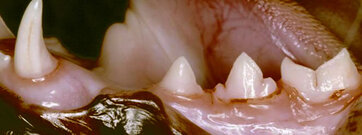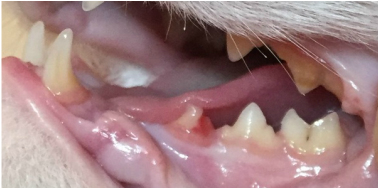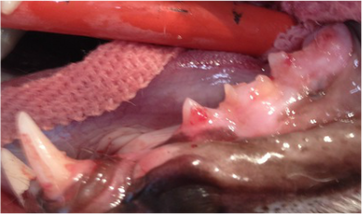Dr Jo Blogs
Expert Cat Care Advice
How can I look after my cat's teeth?
Dr Jo Lewis MRCVS | 13 Sep 2021 | 5 min read
Share:
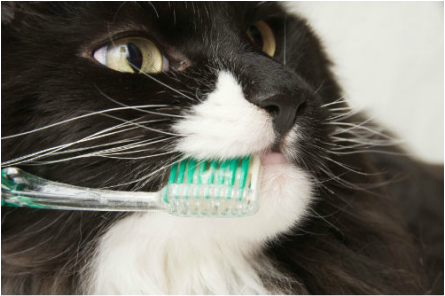
At each six monthly visit, I routinely check your cat’s teeth and gums. If any problem areas can be seen I explain what can be done at home to improve any dental issues and in the event the disease may have advanced beyond what home care alone can manage, I can suggest the best way forwards.
Veterinary dentistry is now a specialized field in its own right. That said, the vast majority of dental procedures can be managed without referral. When we go to the dentist ourselves our teeth are scaled, polished and careful assessments are made about whether xrays and extractions are required. All this is recorded for future reference. This level of service is available for your cat too. Specialized dental instruments and even xray machines are becoming more mainstream at veterinary practices and provide the ultimate level of care for your cat's teeth. You can be reassured that I also have the expertise needed to advise you on the best way to get your cat's mouth back to a healthy state that you can then manage at home.
With 70 percent of cats showing signs of oral disease by three years of age, dental hygiene and regular vet checks are vital to ensuring you cat lives a pain-free and healthy life. Smelly breath (halitosis) is often thought to be a fact of life but in reality it is one of the first signs of dental disease.
Dental disease doesn't only affect your cat’s mouth and cause discomfort, it can lead to bone loss and other serious health problems. Pockets of infection can bleed during chewing, allowing the bacteria to enter the blood stream, which can lead to heart, lung and kidney disease which is another reason regular dental care is so important to every cat’s health - it is definitely not just an older cat problem.
Veterinary dentistry is now a specialized field in its own right. That said, the vast majority of dental procedures can be managed without referral. When we go to the dentist ourselves our teeth are scaled, polished and careful assessments are made about whether xrays and extractions are required. All this is recorded for future reference. This level of service is available for your cat too. Specialized dental instruments and even xray machines are becoming more mainstream at veterinary practices and provide the ultimate level of care for your cat's teeth. You can be reassured that I also have the expertise needed to advise you on the best way to get your cat's mouth back to a healthy state that you can then manage at home.
With 70 percent of cats showing signs of oral disease by three years of age, dental hygiene and regular vet checks are vital to ensuring you cat lives a pain-free and healthy life. Smelly breath (halitosis) is often thought to be a fact of life but in reality it is one of the first signs of dental disease.
Dental disease doesn't only affect your cat’s mouth and cause discomfort, it can lead to bone loss and other serious health problems. Pockets of infection can bleed during chewing, allowing the bacteria to enter the blood stream, which can lead to heart, lung and kidney disease which is another reason regular dental care is so important to every cat’s health - it is definitely not just an older cat problem.
What signs should I look out for when checking my cat’s mouth?
|
Cats may be experiencing mouth pain if they:
|
Other signs of dental disease:
|
Why is it best practice for my vet to x-ray my cat's teeth during each dental procedure?
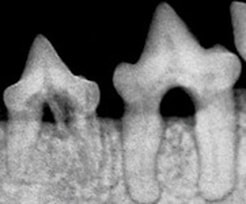
Dental xrays can help to:
Resorptive lesions
Jaw bone loss
Bone tumours/cysts
- Diagnose specific diseases of the mouth such as:
Resorptive lesions
Jaw bone loss
Bone tumours/cysts
- Reassure us that each tooth's roots and bony support structure is healthy. This helps us to monitor (rather than extract) any suspicious looking teeth.
- Allow a complete assessment - in cats, often the tooth crown (the bit we see above the gum line) can look healthy, but lurking underneath, the roots can be diseased meaning the tooth actually needs extraction. Even with the most co-operative cat, it is impossible to assess every surface of every tooth without an anaesthetic. Many cats have large accumulations of tartar on their teeth which can mask any underlying tooth and gum disease.
- Develop the right treatment plan for each cat. As well as assessing the full extent and severity of the disease xrays help in the decision making process as to whether a tooth needs extracting or not.
- Screen cats with missing teeth or those that have had extractions for any traces of residual tooth roots -these can be a potential future source of pain/infection. Domestic cat teeth are extremely fragile and diseased or older cat's teeth even more so. Teeth can therefore break very easily during the extraction process so post-extraction xrays can be a good idea if there is any doubt that some tooth remains.
How can I help to keep my cat's teeth clean & reduce the risk of dental disease?
Brushing your cat's teeth (believe it or not) can be achieved. Granted it is impossible with many cats, but like anything unfamiliar or unpleasant, if your cat is exposed to something in a positive way from an early age it can become a normal part of their healthcare.
Always use a veterinary toothpaste which is safe for cats, like one of those I've suggested in the product links that has enzymatic properties like Virbac or Logic, or even one with antibacterial properties like PetDent. You can get some benefit from just wiping your cat's teeth with the paste as it contains special enzymes to help breakdown the bacterial film on the teeth. Ideally buy a silicone finger brush or a CET veterinary tooth brush to apply the paste rather than contaminating your finger with a plethora of feline mouth germs.
Always use a veterinary toothpaste which is safe for cats, like one of those I've suggested in the product links that has enzymatic properties like Virbac or Logic, or even one with antibacterial properties like PetDent. You can get some benefit from just wiping your cat's teeth with the paste as it contains special enzymes to help breakdown the bacterial film on the teeth. Ideally buy a silicone finger brush or a CET veterinary tooth brush to apply the paste rather than contaminating your finger with a plethora of feline mouth germs.
|
|
|
|
|
|
Products that may be helpful adjuncts to your cat's dental care include:
- PlaqueOff for Cats (a tasty powder that helps soften tartar and is added to wet food in a minute quantity)
|
Always take the advice of your usual vet when introducing other foods or supplemental products as they can still be dangerous in the wrong situation or if you buy the dog version by mistake. Some supplements or products interact with other illnesses/treatments that your cat may have, For example PlaqueOff for Cats contains higher levels of iodine so is not advisable in cats with (or at risk of developing) hyperthyroidism, an over active thyroid.
|
|
What is the most common dental problem I see during my home visits?
|
Other than excessive tartar and gingivitis, the most common dental condition I see is Feline Odontoclastic Resorptive Lesions (FORLs). Sometimes you will hear this referred to as "neck lesions" or odontoclastic resorptive lesions. Regardless of the terminology used, they describe the same condition - a pathological process that starts in the tooth root and results in destruction of the rest of the tooth's structure. X-rays are particularly necessary for cats with Feline Odontoclastic Resorptive Lesions.
The initial tooth root changes are only detectable using x-rays. For this reason routine mouth checks during a checkup consultation will not detect very early lesions, but they will detect the condition once it has spread to the parts of the tooth above the gum line (the tooth "crown"). This may appear as a pink spot or later on an area of red gum tissue growing over the tooth crown. |
If left long enough though, parts of the crown will actually erode away or entire teeth can be missing altogether. Have a look at the comparison photo (left) showing a cat with normal teeth and then a cat with teeth with FORLs at varying stages of the disease process.
Even though 1 in 4 cats suffers from FORLs, it remains unclear why the lesions occur. We do know from humans with the same condition that it can be a painful process. Don't forget that cats are masters of hiding pain from us which usually means that these tooth lesions need to be treated by extracting the affected teeth sooner rather than later. Open tooth lesions like FORLs are also a route for bacteria normally resident in the mouth to access areas deep within and around the affected teeth. This can lead to tooth root infections (abscesses) and even septicaemia once the bacteria enter your cat's bloodstream.
A word about price shopping for cheap veterinary dental care
If done properly, veterinary dentistry under general anaesthesia is often a long and delicate procedure that requires particular attention to temperature, breathing and pain relief. Extracting teeth can be very tricky as a cat's jaw is very fragile and their teeth and roots tiny and brittle and in many cases fused to the boney socket of the jaw itself. So feline dentistry is a particularly fiddly job and involves time, concentration, patience and skill, not brute force.
The extent of dental disease can be very difficult to establish until the individual cat is under anaesthetic. In some cats it is necessary to stage dental extractions on two separate occasions. For all these reasons dentistry can be a potentially costly process. I often give a best/worst case scenario range when estimating dentistry fees to try and prepare owners as much as possible.
Please note: Many vets still do not take x-rays before performing extractions and this can lead to wide variations in cost estimates given. Always ask whether the dentistry fee includes x-rays and if not, consider finding a vet that does provide this level of care as it's far more comprehensive and more akin to the level of human dental care which is far better for your cat. Many pet insurers do not cover dentistry or if they do it's limited to injuries only. I always advise cat owners take out a pet insurance policy that covers more than dental injury alone to avoid future shocks with dentistry costs.
The extent of dental disease can be very difficult to establish until the individual cat is under anaesthetic. In some cats it is necessary to stage dental extractions on two separate occasions. For all these reasons dentistry can be a potentially costly process. I often give a best/worst case scenario range when estimating dentistry fees to try and prepare owners as much as possible.
Please note: Many vets still do not take x-rays before performing extractions and this can lead to wide variations in cost estimates given. Always ask whether the dentistry fee includes x-rays and if not, consider finding a vet that does provide this level of care as it's far more comprehensive and more akin to the level of human dental care which is far better for your cat. Many pet insurers do not cover dentistry or if they do it's limited to injuries only. I always advise cat owners take out a pet insurance policy that covers more than dental injury alone to avoid future shocks with dentistry costs.

